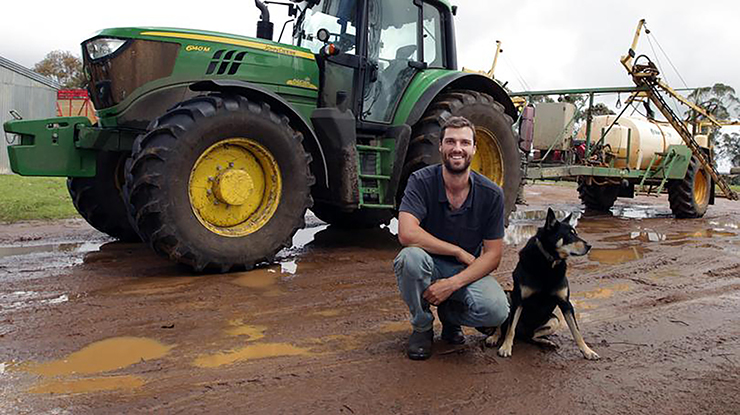Winter wheat grows profitability
26 June 2024
 Tim Metcalfe now has a new forage option to bridge the winter feed gap. Image credit: Laurie Benson, Albany Advertiser
Tim Metcalfe now has a new forage option to bridge the winter feed gap. Image credit: Laurie Benson, Albany Advertiser
Tim Metcalfe has been a long-term user of grazing canola to bridge the winter feed gap on his property in the Porongurup region of WA – and he has now added a new forage option into the mix.
His involvement in the MLA-funded ‘Alternate forage crops for Southern WA’ Producer Demonstration Site (PDS), run by the Stirlings to Coast Farmers group, offered Tim his first foray into using wheat as a grazing option.
Tim, along with his brother Chris and their parents Christine and Richard, produces seedstock Angus and Murray Grey cattle, alongside a commercial beef herd and crossbred lambs.
The Metcalfes were regularly grazing canola to defer stocking their pastures. When Stirlings to Coast Farmers learned what they were doing, they approached them to take part in the PDS.
“We’re in the high rainfall zone, so not a lot of our farm is suitable for cropping,” Tim said.
“We’re limited to the paddocks we can crop without the risk of water logging. Adding the wheat into our rotation allowed us to optimise our cropping program, and the wheat stubble is better than canola for grazing in summer as well.”
PDS insights
In 2022, as part of the trial, Tim grazed 25.5ha of ryegrass/clover pasture with 35 yearling steers and compared the results to 85ha of DS Bennett winter wheat which was grazed with 210 yearling heifers.
DS Bennett produced more than twice the biomass of the clover ryegrass pasture. Cuts taken prior to grazing returned a result of 3.88t/ha compared to 1.86t/ha for ryegrass/clover.
Nutrient value analysis was similar for both feed sources, with DS Bennett recording a slightly higher feed quality:
- crude protein – as % of dry matter (DM) – was 21.7 compared to 20.0 for ryegrass/clover
- digestibility (% of DM) was 84.3 compared to 71.1
- metabolisable energy (MJ/kg of DM) was 12.9 compared to 10.6.
The yearling steers grazing the ryegrass/ clover gained 74kg on average, while the heifers grazing the DS Bennett gained an average of 48kg.
However, because of the greater biomass produced and the higher stocking rate, when compared in kg/ha/day the alternate forage performed better.
DS Bennett saw the heifers gain 0.43kg/ha/day more than the steers on the ryegrass/clover, resulting in a total livestock weight gain of 17.2kg/ha more. This equated to a profit of $583/ha for the DS Bennett, compared to $498/ha for the ryegrass/clover.
Range of options
Tim said a further advantage of using the winter wheat for grazing option was the range of options it offered, over and above grazing.
“We cut 17ha for silage, which yielded 290 rolls at approximately 700kg each (12t/ha). We took the remaining 68ha through to harvest, with an average yield of 3.6t/ha,” he said.
This versatility translated to greater overall profitability for DS Bennett of an extra $85/ha, with the silage and grain providing additional revenue.
The results from the PDS convinced the Metcalfes to keep winter wheat in their rotation going forward. They have switched from DS Bennett to Illabo, a shorter season variety that works in better within their operations.
“Having a winter wheat in our system has allowed us to increase our profits,” Tim said.
“It gives us large amounts of grazing and, at the end, we’ve deferred our pastures, so we’ve got extra feed in the spring. Being able to lock the wheat up for a cash crop at the end is just a bonus.”


